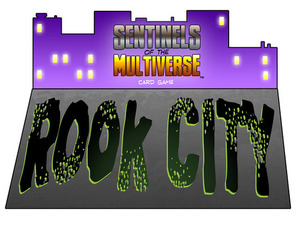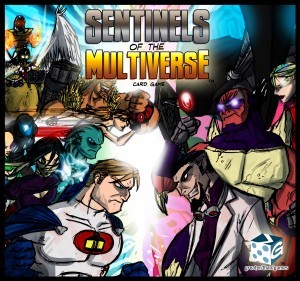Sentinels of the Multiverse: Rook City - A Review
 Thursday, May 24, 2012 at 01:53AM
Thursday, May 24, 2012 at 01:53AM 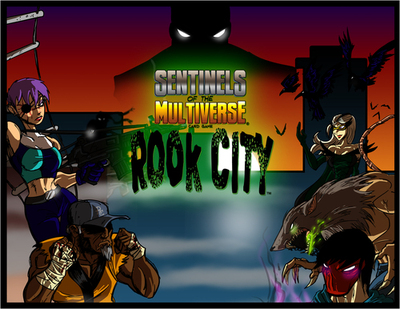
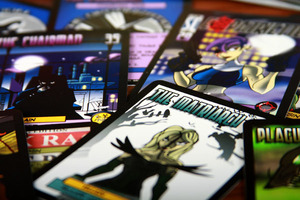 Over the past few months, Greater Than Games' superhero card game Sentinels of the Multiverse has seen quite a bit of table time at my place. Its thematic roller-coaster pacing only seems to get better as time goes on. Rook City, the first expansion to the series, ratchets up the fun through the inclusion of new villains, heroes, and environments from the seedy underbelly of the sprawling Rook City. The expansion also subtly adds to the game mechanics a bit, by adding a new scaling mechanism that helps the game maintain balance with differing player counts, as well as a couple of new attributes that modify how much damage can be dealt during an attack.
Over the past few months, Greater Than Games' superhero card game Sentinels of the Multiverse has seen quite a bit of table time at my place. Its thematic roller-coaster pacing only seems to get better as time goes on. Rook City, the first expansion to the series, ratchets up the fun through the inclusion of new villains, heroes, and environments from the seedy underbelly of the sprawling Rook City. The expansion also subtly adds to the game mechanics a bit, by adding a new scaling mechanism that helps the game maintain balance with differing player counts, as well as a couple of new attributes that modify how much damage can be dealt during an attack.
Christopher Badell, Greater Than Game's Design Director, was kind enough to speak with us about the Rook City expansion when it was being funded on Kickstarter, so it was a treat to finally bring the game to the table, and see what Greater Than Games had really been plotting in their hidden fortress. Since I have previously reviewed the Sentinels of the Multiverse base game, I am not going to talk about the rules of the core game, but instead focus on the successful tweaks to the formula, as well as the interesting and engaging characters and environments that have been introduced into GTG's Multiverse.
Components:
Like Sentinels of the Multiverse, Rook City maintains the card based nature of the game. Even without a box full of components, Rook City manages to capture the visceral essence of a comic book story. It shares the same expressive, colorful artwork that the original game introduced, through the quality cards and colorful box.
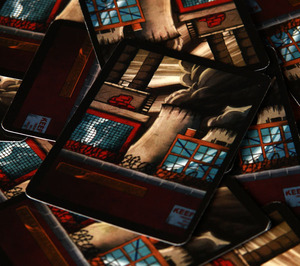 The biggest visible difference with Rook City is its box. Not only does it have a higher quality linen finish, but it contains a custom insert that holds the cards perfectly, and removes the need to separately bag cards. The custom insert is a step in the right direction, but there are still some issues with the new box as a storage solution. First of all, it isn't really built to hold all of the cards in the game - the cards from the base game, and the Rook City cards will have to stay quarantined in their own respective boxes. Second, there is no easy way to separate the cards. The way the cards are stored in the new box doesn't really allow for baggies or tabbed separators. (However, Greater than Games is addressing this issue in tandem with the second expansion, by releasing a new box that will hold all of the cards for the base game and expansions.) When push comes to shove, though, the amount of space that Sentinels and Rook City take up on a shelf is still much less than most deck builders.
The biggest visible difference with Rook City is its box. Not only does it have a higher quality linen finish, but it contains a custom insert that holds the cards perfectly, and removes the need to separately bag cards. The custom insert is a step in the right direction, but there are still some issues with the new box as a storage solution. First of all, it isn't really built to hold all of the cards in the game - the cards from the base game, and the Rook City cards will have to stay quarantined in their own respective boxes. Second, there is no easy way to separate the cards. The way the cards are stored in the new box doesn't really allow for baggies or tabbed separators. (However, Greater than Games is addressing this issue in tandem with the second expansion, by releasing a new box that will hold all of the cards for the base game and expansions.) When push comes to shove, though, the amount of space that Sentinels and Rook City take up on a shelf is still much less than most deck builders.
New Mechanics:
Rook City introduces some new mechanics to the game. Unlike expansions in many other games, these rules are all self contained. The basic game rules remain untouched, and new mechanisms are introduced only in the card text of the Heroes, Villains and Environments in Rook City. Since cards from different games are never shuffled together into a single deck, it allows GTG to craft new play experiences in Rook City, without affecting the play experience in the base game.
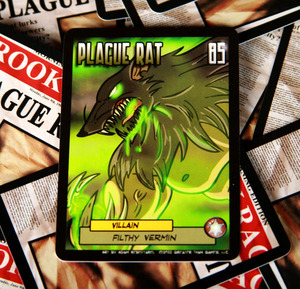 The first, and most important change is the addition of a new symbol to Rook City cards. This symbol looks like an H with a circle around it, and is always interpreted as the number of heroes in the current game. One of my concerns with the base game, was that it did not scale well. The villains and environments had a fixed difficulty regardless of the number of players. This made a 3 player game much harder than a 4 player game. With this new scaling mechanic, however, the Rook City villains and environments can now scale in difficulty based on the player counts. It's always a bit scary when game designers start tinkering with a system that already works, but I am happy to say that Rook City maintains the dynamic, tense flavor of Sentinels, only now it allows for a much more flexibility in player count.
The first, and most important change is the addition of a new symbol to Rook City cards. This symbol looks like an H with a circle around it, and is always interpreted as the number of heroes in the current game. One of my concerns with the base game, was that it did not scale well. The villains and environments had a fixed difficulty regardless of the number of players. This made a 3 player game much harder than a 4 player game. With this new scaling mechanic, however, the Rook City villains and environments can now scale in difficulty based on the player counts. It's always a bit scary when game designers start tinkering with a system that already works, but I am happy to say that Rook City maintains the dynamic, tense flavor of Sentinels, only now it allows for a much more flexibility in player count.
The other two changes to the game's mechanics are more minor, although fairly pervasive throughout the new decks. One identifies a target as invulnerable, while the other ensures that damage done cannot be reduced in potency. These effects could have been written into the descriptions on the appropriate cards, but by introducing them as keywords, a lexicon is being created for the game that can be built upon in later expansions. Although these new mechanisms may seem minor, the cards that utilize the new keywords can really add a feeling of both power and dread to the game, further supporting the cinematic feel of the game.
Cast of Characters:
When it comes down to it, the success and charm of both Sentinels of the Multiverse and Rook City are delivered though the individual characters in the game: the villains, heroes, and environments. Yes, I realize that I just called the environment a character in the game, but I still believe that the environments have so much character, they become anthropomorphic in their own right. Since the characters are the heart and soul of the expansion, I would like to talk about each of these 8 personalities separately.
Villains
The Organization - The Organization is a corporate juggernaut that secretly controls Rook City in it's shadowy back rooms. Led by a man called only "The Chairman", and kept in line by a formidable woman known as "The Operative", The Organization is a doubly tough nut to crack.
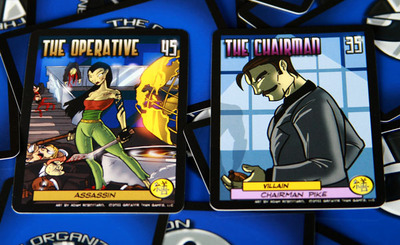 Where most villains have a single leader that needs to be defeated, The Organization starts with two villains on the table. In line with the typical hierarchy of a corporation, players will have to fight tooth and nail through a bureaucracy before finally defeating The Chairman. The way The Organization deck is structured, there are various underbosses who continue to bring thugs into play; and The Operative, who brings the various Underbosses into play. Not only are waves upon waves of minions delivered to the players during the battle, but the Chairman is completely untouchable until The Operative has been dispatched.
Where most villains have a single leader that needs to be defeated, The Organization starts with two villains on the table. In line with the typical hierarchy of a corporation, players will have to fight tooth and nail through a bureaucracy before finally defeating The Chairman. The way The Organization deck is structured, there are various underbosses who continue to bring thugs into play; and The Operative, who brings the various Underbosses into play. Not only are waves upon waves of minions delivered to the players during the battle, but the Chairman is completely untouchable until The Operative has been dispatched.
The thought that was put into this villain deck to create mechanisms that reinforce the feeling of a corporate hierarchy are incredibly inspired. This is the sort of attention to detail that gives Sentinels it's uniquely effective theme without having to punt on the gameplay. This villain deck reminds me of a Saturday Morning Cartoon, or an 8 bit beat 'em up video game; the players have to battle through what seems like an unending wave of thugs in order to defeat the mini-bosses, and the end culminates in a two part boss battle where the boss's defenses have to be penetrated before he can be ultimately defeated. This is a narrative arc that has been found in movies, books, and video games for years, because it works so well at an instinctual level. It's no surprise that it works in Rook City as well, as this is a very dynamic and tense battle.
Spite - Spite's story taps into the idea of the government meddling in the affairs of men and creating damage that it cannot control. Similar to the theme in classics like "A Clockwork Orange", where the government uses prisoners as test subjects for questionable experiments, Spite's story is one of a serial killer who is given an opportunity to commute his death sentence by being a lab rat. Unfortunately, the experiments that were performed turned Spite into a monster of unimaginable violence and power. He easily escaped his confines, and now roams the city feeding his unquenchable thirst for murder and pumping his twisted body full of chemicals that give him superhuman strength.
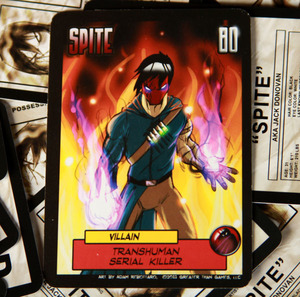 Spite's deck is very unique, and has two main themes that run through it. The first is his insatiable need to kill innocent people. Throughout the deck are victim cards that represent innocents which the heroes can save by completing tasks on the card's text. If the heroes chose not to save the victims, they are quickly dispatched by cards brought into play from the villain deck, causing damage to the heroes, or greater strength to Spite. This is another clever mechanic that forces players to act like heroes. In most of the other villain decks, the heroes are put into a position where fighting is the only purpose, however Spite's deck introduces heroic sacrifices that the players must perform in order to save innocent victims. This changes the mood of the game and the motivation of the players, and surprisingly ratchets up the SuperHERO nature of the game.
Spite's deck is very unique, and has two main themes that run through it. The first is his insatiable need to kill innocent people. Throughout the deck are victim cards that represent innocents which the heroes can save by completing tasks on the card's text. If the heroes chose not to save the victims, they are quickly dispatched by cards brought into play from the villain deck, causing damage to the heroes, or greater strength to Spite. This is another clever mechanic that forces players to act like heroes. In most of the other villain decks, the heroes are put into a position where fighting is the only purpose, however Spite's deck introduces heroic sacrifices that the players must perform in order to save innocent victims. This changes the mood of the game and the motivation of the players, and surprisingly ratchets up the SuperHERO nature of the game.
The second theme in the Spite deck is chemical mutation. Along with the victim cards in the deck are a collection of chemicals and mutagens that strengthen and change Spite's behavior, forcing players to balance their attacks on Spite with the attempts to save the innocents, and causing the flow of the game to swing between the two objectives.
I find it very refreshing that the Villains themselves really dictate the theme of the play experience, and each one can be drastically different. This modular nature makes me excited for the future of Sentinels, and the ability for the game to persist and continue to deliver new and unique play experiences without the need to rework the core mechanics.
The Matriarch - The Matriarch takes a page out of Alfred Hitchcock's playbook by making birds terrifying again. The Matriarch's power is granted by a magical mask that allows her to commune with the flocks of avian minions.
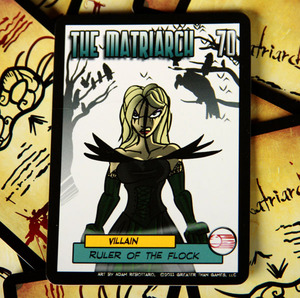 The key theme in The Matriarch's deck is swarming. As long as her mask is in play, the villain deck is cycled, bringing continued destruction to the table until more birds appear. This causes the play area to fill up with more birds every turn, turning the play area into a seemingly unending cloud of wings and beaks.
The key theme in The Matriarch's deck is swarming. As long as her mask is in play, the villain deck is cycled, bringing continued destruction to the table until more birds appear. This causes the play area to fill up with more birds every turn, turning the play area into a seemingly unending cloud of wings and beaks.
Like the previous villains, The Matriarch's deck is very thematic in its execution. The mechanics that bring about this feeling don't seem as creative as the other villains, though. The Matriarch has less of a roller coaster pacing to her cards, and instead feels a bit more like a hopeless grind to the finish. That's not to say that she isn't a compelling villain, just that the others produce a more interesting play experience.
Plague Rat - Plague Rat is a mutant half-man half-rat produced from the mixture of drugs and toxic waste spewed from the poorly regulated factories and industrial plants in Rook City. While years of criminal control has transformed Rook City into a toxic hive of villainy, the corrupted sewers have turned this former drug dealer into a noxious villain.
Like Teenage Mutant Turtles gone horribly wrong, Plague Rat could be likened to an evil alter ego of the good and protective Splinter. With veins filled with pestilence and toxins, Plague Rat's bite has lasting effects, 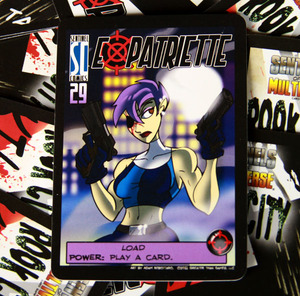 theming his villain deck with poison and infection. Where other villains bring minions to the table that protect and divert attention, this rat-man wages a one-on-one battle with the heroes using only his debilitating bite which can turn the heroes against each other and themselves. Once all of the heroes are infected, their only remedy against the poison is to do damage to friendly targets.
theming his villain deck with poison and infection. Where other villains bring minions to the table that protect and divert attention, this rat-man wages a one-on-one battle with the heroes using only his debilitating bite which can turn the heroes against each other and themselves. Once all of the heroes are infected, their only remedy against the poison is to do damage to friendly targets.
I really enjoy the way that Plague Rat mixes up the Sentinels formula. By forcing the players to attack each other, it creates the feeling that the heroes are afflicted by a mind altering pathogen that turns the conflict against Plague Rat into a conflict of self as well. When you think about it, that is a pretty deep theme for a simple card game.
Heroes -
Expatriette - The first of the two heroes included in the Rook City expansion would give John Rambo a run for his money. Daughter of the villain "Citizen Dawn" in the main Sentinels game, Expatriette is a master of firearms with her sights on bringing justice to the world one bullet at a time.
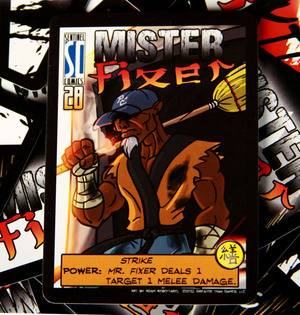 Expatriette's deck is filled with firearms and ammunition, and her gameplay is all about swapping weapons and keeping them loaded with a variety of different types of rounds. Playing this harbinger of pure firepower is like standing next to a hailstorm of bullets. It's easy to imagine the game shifting into slow motion as the smoke swirls around her and the bullet casings spill to the ground, clinking against the pavement like steel rain. She may be straightforward to play, but the feeling of pure unadulterated firepower she presents is a lot of fun.
Expatriette's deck is filled with firearms and ammunition, and her gameplay is all about swapping weapons and keeping them loaded with a variety of different types of rounds. Playing this harbinger of pure firepower is like standing next to a hailstorm of bullets. It's easy to imagine the game shifting into slow motion as the smoke swirls around her and the bullet casings spill to the ground, clinking against the pavement like steel rain. She may be straightforward to play, but the feeling of pure unadulterated firepower she presents is a lot of fun.
Mr Fixer - If Mr. Miyagi from the Karate Kid dropped the home maintenance angle and decided to start breaking evil's kneecaps, the result would be Rook City's Mr. Fixer - an ex martial arts instructor, who has turned his life to the pursuit of extracting justice for the brutal slaying of his students.
With an arsenal of car repair tools and knowledge in a myriad of martial arts styles, he is a force to be reckoned with; changing up his nature like others change clothes, and keeping his enemies guessing. Through the use of the different cards in his deck that represent tools and fighting styles, Mr. Fixer plays like a bunch of different characters in one. Choosing what style to use at any given moment can be very strategic, and empowers the player to feel like he is defeating his enemies not only with superhero skills, but with a calculating mind as well. While more subtle than Expatriette, he is just as fun to play.
Environments -
Rook City - Rook City is dangerous in many ways. Its sewers run green with toxic sludge, its crumbling buildings threaten to crush the unaware, and dangerous criminals roam it's darkened alleys. The villains that the heroes must confront are tough, but the city itself may be their toughest obstacle. That's not to say that Rook City doesn't have it's share of citizens working for the greater good. Even in an unlikely place like this, heroes may find some allies... or at least distractions for the enemy.
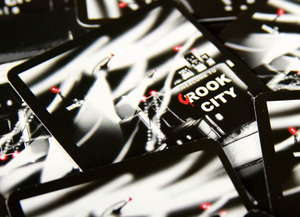 The Rook City deck may represent the most common type of environment found in comic books - the crime infested city. This common theme isn't a bad thing though, as it fills a thematic hole in the base game. The heroes of Sentinels needed a city to clean up, and it has been graciously delivered to them by Greater Than Games in the form of Rook City.
The Rook City deck may represent the most common type of environment found in comic books - the crime infested city. This common theme isn't a bad thing though, as it fills a thematic hole in the base game. The heroes of Sentinels needed a city to clean up, and it has been graciously delivered to them by Greater Than Games in the form of Rook City.
Industrial Complex - Lots of crazy things can happen in an Industrial Complex when there is little to no regulation. Filled with science experiments gone bad, the complex in Rook City has wonders that can both help and hinder hero and villain alike. But some of the technology found here isn't fully baked, and can combust in a shower of green goo and pain. Oh.. and watch out for the vermin that roam the dingy hallways - this Industrial Complex prefers to spend it's money on research over sanitation.
Unlike the Rook City deck that seems tipped in the villains' favor, the Industrial Complex is fairly neutral. The different vat cards stay in play and have effects on both villains and heroes alike. Sprinkled through the environment deck, however, are chemical explosions which cause the vats to blow up, and cause damage to all targets in play. The rat cards in the deck can be a hindrance, but if the experimental mutagen card comes into play, all of the rats will come out of the discard pile, and they will be much tougher to defeat.
Out of the two environments, I think that the Industrial Complex is my favorite. The cards within the deck seem to have more interplay with each other, and there is a lot more potential for catastrophic damage, both to the heroes and the villains.
Conclusion:
All in all, I was extremely impressed with Rook City. Not only did it rectify some of the scaling issues from the base game, but the heroes, villains, and environments were all a blast to play. The components themselves were also upgraded with higher quality cards and a box that allowed for better organization.
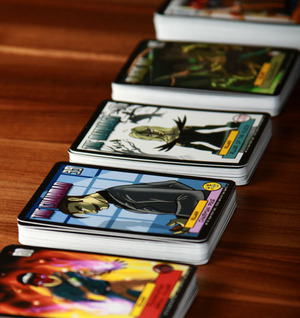 The only complaints that I have about the expansion are minor. While the box is better than the one in the first game, it still doesn't really address the storage problem with the game. Greater Than Games has plans to address this in upcoming releases, but until it is in my hot little hands, I'll have to make due.
The only complaints that I have about the expansion are minor. While the box is better than the one in the first game, it still doesn't really address the storage problem with the game. Greater Than Games has plans to address this in upcoming releases, but until it is in my hot little hands, I'll have to make due.
I suppose that it is also bit disappointing that the scaling mechanic only works for the Rook City cards. It would be nice to have the effects retroactive into the base game. This too is being addressed in a re-release of the base game, though, so players will soon have the opportunity to play with the best of both worlds.
It's rare that I have practically nothing negative to say about a game, and wax lyrical about it instead, but I find myself in that position with Sentinels of the Multiverse: Rook City. The additions in the expansion only work to enhance the game experience, and every one of them is welcome and well conceived. If you own Sentinels of the Multiverse already, Rook City is a must buy. If you don't own Sentinels of the Multiverse, wait for the second edition of Sentinels to be released, and then buy it - along with Rook City!

